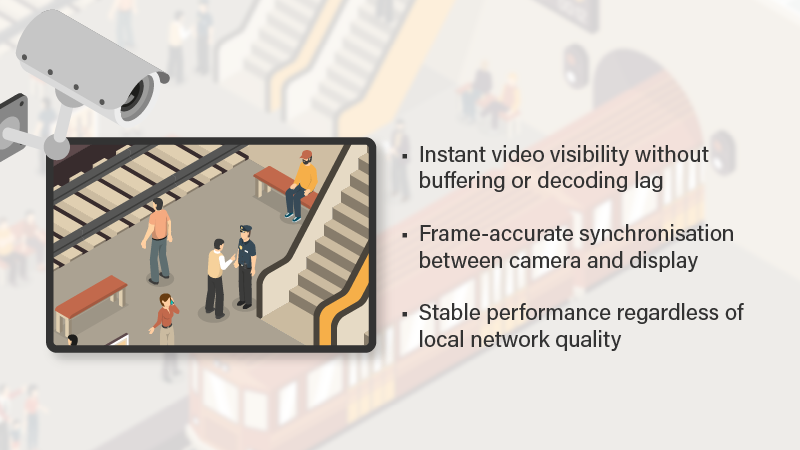


In fast-paced surveillance environments, decisions are often made in a matter of seconds. Whether it’s identifying an intruder, managing platform crowd flow, or responding to an unexpected event, the ability to view real-time footage without delay can directly impact the outcome. While IP-based surveillance systems have gained popularity for their flexibility and remote access capabilities, they’re not always the best fit—particularly in locations where low latency and rapid deployment are non-negotiable.
Today’s mission-critical monitoring stations—found in train platforms, control centres, and industrial sites—require technology that responds as quickly as the people operating it. These are the settings where SDI surveillance monitors continue to excel. Their reliability, speed, and simplicity give them a distinctive advantage, especially when clarity and immediacy are more valuable than connectivity.
Low-latency monitoring refers to the ability to view live video footage with virtually no delay between capture and display. In security applications, this means that the moment something happens, the operator sees it instantly—without buffering, decoding, or lag caused by overloaded networks. For professionals working on the front lines of surveillance, such responsiveness can be the difference between proactive prevention and delayed reaction.
Unlike IP systems that transmit compressed video over networks, SDI monitors receive uncompressed signals directly from the camera through coaxial cables. This allows frame-accurate synchronisation and eliminates the latency that may occur due to network congestion or software processing. In high-risk zones—like airport terminals or entrance checkpoints—this real-time visibility is not just helpful; it’s essential. Not familiar with SDI yet? Start with our primer on what SDI is and how it became a surveillance standard.
Time is often a constraint for integrators managing multiple sites or retrofitting existing systems. In such cases, SDI monitors offer a clear advantage. Many older buildings still have legacy coaxial infrastructure in place, and SDI displays can be integrated without replacing cabling or modifying core system architecture. A plug-and-play setup allows installers to connect cameras and displays quickly, reducing deployment time and eliminating the need for complicated network configuration.
Beyond rapid setup, SDI monitors with loop-through BNC output provide practical flexibility by enabling signal extension to additional monitors or recording systems. This is particularly useful in security stations where simultaneous monitoring across several screens is required.
One of the more overlooked benefits of SDI is its ability to operate completely independent of IP networks. In areas with unstable bandwidth, strict IT policies, or no internet access at all, SDI offers a direct and dependable video link. It supports on-site personnel with uninterrupted live views and avoids the performance drops often caused by bandwidth congestion, firewall restrictions, or router failures.
In control rooms and guard stations, SDI also enables split viewing—allowing staff to view the same feed that is being recorded elsewhere, without compromise in resolution or frame timing. For unmanned or partially connected sites, this simplicity is often what makes the difference between having surveillance—and having effective surveillance.
Beyond clarity and speed, SDI monitors are also built to last. In environments where surveillance must run 24/7, displays need to be designed for continuous use. Commercial-grade SDI monitors address this by offering protection against static image retention, strengthened housing to withstand physical impacts, and internal components that resist wear from dust or vibration.
Whether installed in transit control centers, logistics depots, or industrial command rooms, the monitor becomes a mission-critical component—one that must maintain image performance under pressure and over time. The longevity and durability of SDI displays directly contribute to reduced maintenance, fewer replacements, and better return on investment.
Mission-critical surveillance doesn’t stop, and neither should the monitor. That’s why commercial SDI displays are built for:
These qualities help minimize downtime and extend lifecycle costs in busy or industrial deployments. If you’re planning a new deployment, this guide on choosing the right SDI monitor may help you evaluate key specs.
While network-based systems continue to evolve and offer valuable features for remote access and cloud storage, the foundational benefits of SDI remain essential. Its low-latency performance, reliable signal delivery, and ease of integration make it a strong option for any security setup that demands real-time response and system resilience.
SDI technology is not outdated—it’s purpose-built. In a surveillance world where reliability often trumps complexity, and where uptime is more important than bells and whistles, SDI offers a straightforward answer to a complicated problem.
AG Neovo’s SDI monitor range is designed to support these priorities, offering models in Full HD and 4K resolutions, from 24″ to 75″, with BNC input/output, 24/7 operation, and robust construction. Whether you’re working with existing coaxial infrastructure or simply seeking a monitor you can trust in high-risk environments, SDI displays remain a dependable choice in a changing landscape.